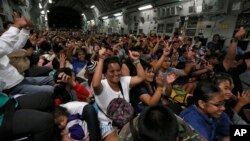MANILA —
In the Philippines, the exodus from the worst-hit area of Tacloban continues, more than two weeks after a powerful typhoon laid waste to the country's central provinces. The typhoon left more than 5,200 dead and about 1,500 missing. Some of the evacuees have gone to Manila where they are welcomed with a host of social services and a little entertainment.
With the ending bell, the crowd in the grandstand inside Villamor Air Force Base in Manila roared to its feet as Philippine boxing mega-star Manny Pacquiao finisheed off Brandon Rios to snag another division title.
The audience was made up mostly of social workers, volunteers and service personnel who watched the live bout on a big screen. But a few evacuees from the typhoon-stricken central Philippines were able to join in.
Maria Nenita Tolibas and her family from Tacloban survived Super Typhoon Haiyan’s powerful winds and massive storm surge that left thousands dead in her city.
She said watching Pacquiao’s win helped to lift her spirits and it was like recovering from the storm. She also hoped her neighbors in Tacloban got a chance to see the match so they could experience a little joy.
Tolibas is one of about 15,000 people in Manila who left the devastation of their hometowns. She said her family planned to stay temporarily in the metro area and return when Tacloban was in better shape.
Typhoon Haiyan left behind a hard-to-penetrate jumble of broken trees, downed power lines, upturned cars and housing debris. It knocked out electricity in a number of municipalities and in entire provinces including Leyte, Samar and Biliran. It also brought down communication lines and almost completely obliterated houses in a number of towns and villages.
Civil Defense officials said the government had identified five areas for building temporary housing in the hardest-hit towns and cities of Leyte and neighboring Samar, where the main sources of income are subsistence farming and fishing. The government’s socio-economic department is putting together a short-term recovery plan to be presented within days to the president, to address basic needs for the 4.3 million displaced people. Officials said the cost of rebuilding could be nearly $6 billion.
As attention turns to recovery, the government continues to assess cases of people who have left their typhoon-stricken communities for metropolises like Manila. A majority of those who arrive are with their entire families.
Froilan Maglaya with the Department of Social Welfare and Development is one of the emergency response coordinators at the Air Force Base. He said the reality was that many family members of the displaced arriving in Manila were themselves not financially able to take in the big groups of survivors.
“We want them to express ‘Well I have an extra space and then we can accommodate them.’ Our fear is that they might end up on the streets if they are not assessed properly,” he said.
Maglaya said if the evacuees chose to stay in Manila, there were temporary shelters, but the priority was to get them employed so they could be self-reliant.
With the ending bell, the crowd in the grandstand inside Villamor Air Force Base in Manila roared to its feet as Philippine boxing mega-star Manny Pacquiao finisheed off Brandon Rios to snag another division title.
The audience was made up mostly of social workers, volunteers and service personnel who watched the live bout on a big screen. But a few evacuees from the typhoon-stricken central Philippines were able to join in.
Maria Nenita Tolibas and her family from Tacloban survived Super Typhoon Haiyan’s powerful winds and massive storm surge that left thousands dead in her city.
She said watching Pacquiao’s win helped to lift her spirits and it was like recovering from the storm. She also hoped her neighbors in Tacloban got a chance to see the match so they could experience a little joy.
Tolibas is one of about 15,000 people in Manila who left the devastation of their hometowns. She said her family planned to stay temporarily in the metro area and return when Tacloban was in better shape.
Typhoon Haiyan left behind a hard-to-penetrate jumble of broken trees, downed power lines, upturned cars and housing debris. It knocked out electricity in a number of municipalities and in entire provinces including Leyte, Samar and Biliran. It also brought down communication lines and almost completely obliterated houses in a number of towns and villages.
Civil Defense officials said the government had identified five areas for building temporary housing in the hardest-hit towns and cities of Leyte and neighboring Samar, where the main sources of income are subsistence farming and fishing. The government’s socio-economic department is putting together a short-term recovery plan to be presented within days to the president, to address basic needs for the 4.3 million displaced people. Officials said the cost of rebuilding could be nearly $6 billion.
As attention turns to recovery, the government continues to assess cases of people who have left their typhoon-stricken communities for metropolises like Manila. A majority of those who arrive are with their entire families.
Froilan Maglaya with the Department of Social Welfare and Development is one of the emergency response coordinators at the Air Force Base. He said the reality was that many family members of the displaced arriving in Manila were themselves not financially able to take in the big groups of survivors.
“We want them to express ‘Well I have an extra space and then we can accommodate them.’ Our fear is that they might end up on the streets if they are not assessed properly,” he said.
Maglaya said if the evacuees chose to stay in Manila, there were temporary shelters, but the priority was to get them employed so they could be self-reliant.

